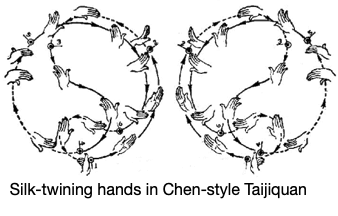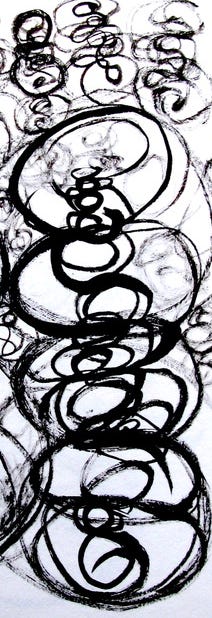Yin-Yang Chansigong (陰陽纏絲功) is an important taijiquan practice for developing continuity and power. Chansigong, or ‘silk-twining’ brings together taijiquan core-principles with taijiquan forms and can be understood as the glue that binds theory and practice.
Taijiquan Yin-Yang Silk Twining Training (Yin-Yang Chansigong 陰陽纏絲功)
Silk twining is most often associated with Chen-style Taijiquan and, to a lesser extent, with Wu-style Taijiquan, however, it is also very much a component of the Yang-style Taijiquan. While it is greatly beneficial to all areas of internal-arts training, chansigong is almost completely unknown to Yang-style Taijiquan players as it has traditionally been taught in ‘closed-door’ settings.
Three terms are commonly used in relation to chansi practice. The most frequently used is ‘chansijin’ (纏絲勁) which refers to the martial-kinetic qualities (jin 勁) of the twining actions. The word ‘chansigong’ (纏絲功) refers to practices (gong 功) that use chansijin. A less-known term, ‘chansijing’ (纏絲精), refers to the internal energy (jing 精) gradually accumulated by chansigong.
What is ‘silk-twining?’
The Chinese word chan (纏) means ‘to twine,’ ‘entwine,’ ‘entangle,’ ‘wrap around,’ or ‘reel.’ Si (絲) means ‘silk’ or ‘thread.’ ‘Chan’ and ‘si’ together form ‘chansi’ which is usually translated as ‘silk reeling,’ silk winding,’ or, more simply, as ‘coiling’ or ‘twining.’
The chansi analogy is usually said to refer to the drawing of fibrous silk threads from a cocoon created by a silkworm in order to house its transformation into a moth or butterfly. Chansi can also be thought of as the wrapping of the silk around a spool. Another imagining of the chansi suggests the spinning of the silkworm itself as it generates the cocoon. The silk-twining idea suggests also that an opponent can become entangled, entwined, and stuck in the sticky web of silk.
These images provide metaphors for the many small actions within the chansigong exercises and for the characteristic way movement unfolds in taijiquan and other neijiaquan arts. Chansi, both as an energy (jin 勁) and a practice (gong 功), supports the ‘sticking-adhering energy’ (zhan-nian jin 粘黏勁) approach to martial-arts training and is closely related to the twenty-five energies of Taijiquan’s Theory of Energy (Taijiquan Lun Jin 太極拳論勁) found in Chen Yanlin’s (陳炎林) 1943 Taiji Boxing, Sabre, Sword, Pole, Sparring Compiled (Taiji Quan, Dao, Jian, Gan, Sanshou Hebian 太極拳刀劍桿散手).
Silk twining as an independent solo practice
The characteristics of silk twining are built into taijiquan solo-and-partner forms and practices and therefore, to a certain extent, it can be reasonably thought unnecessary to practice silk-twining exercises as independent solo practices. This assumes, however, that students are practicing their forms with correct chansi alignments and sequencing—which is rarely the case. If this level of connection is absent or faulty, a gap between principle and practice exists. Therefore, independent chansi practice can benefit the practitioner in their efforts to master the art.
Silk-twining solo exercises can be likened to other practices designed to bolster taijiquan progress, such as; standing-post training, qigong and meditation exercises, strength and flexibility training, etc. Such practices are used to augment the strict taijiquan practices to the point of being part of the art’s curriculum. Compared to the above-mentioned methods, however, silk twining is baked into every aspect of the art, therefore, silk-twining solo practices can be considered an essential part of training.

Silk twining as peng and an
In Yin-Yang Chansigong, all actions support and result in either peng (‘ward,’ 掤) or an’ (‘press,’ 按). Since the terms ‘yang’ (陽) and ‘yin’ (陰) refer to the ‘rolling direction’ of the movements—yang is forward rolling and yin is backward rolling—it is possible to see gestures that express the following:
Forward-rolling peng
Backward-rolling peng
Forward-rolling an
Backward-rolling an
As the primary-square energies, peng and an provide the basis for virtually all else in taijiquan. Studying these complimentary opposites through chansigong training can benefit practice enormously.
Yin-Yang Chansigong important points
• In Yin-Yang Chansigong, the terms yang (陽) and yin (陰) refer to the ‘rolling direction’ of the movements. ‘Yang’ practices ‘roll’ outward much in the way a wheel rolls forward, while ‘yin’ practices ‘roll’ inward much as a wheel rolls backward.
• Yin-Yang Chansigong involves a continuous interchange between ‘ward’ (peng 掤) and ‘press’ (an 按) and, therefore, supports other peng-an based practices such as the Yang-shi Taiji Changquan (108 long form), taijibaduanjin, dashou, etc.
• The Single-arm Twining Exercises are done in ‘horse stance’ (mabu 馬步) only. Although shifting toward the left or right side begins to imply a 'bow stance' (gongbu 弓步), the horse stance should be maintained throughout. Maintaining the horse stance requires discipline but produces stronger long-term results.
• The yin-yang stance continuum is always at play during weight shifting, however, each of these exercises uses only one half (one side) of the stance—from tai-yin (太陰) yang-ward (陽) to tai-yang (太陽), and then yin-ward (陰) back to tai-yin. Maintaining the half-stance limit requires discipline but produces stronger long term results.
End of Part One








